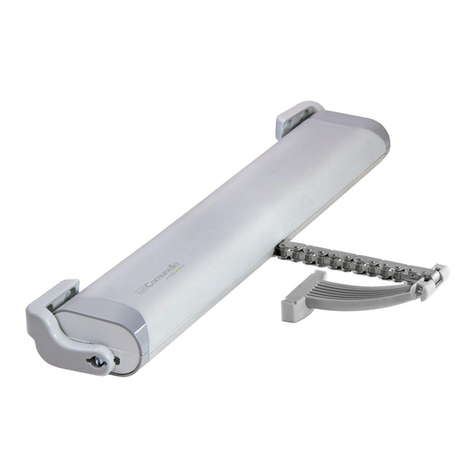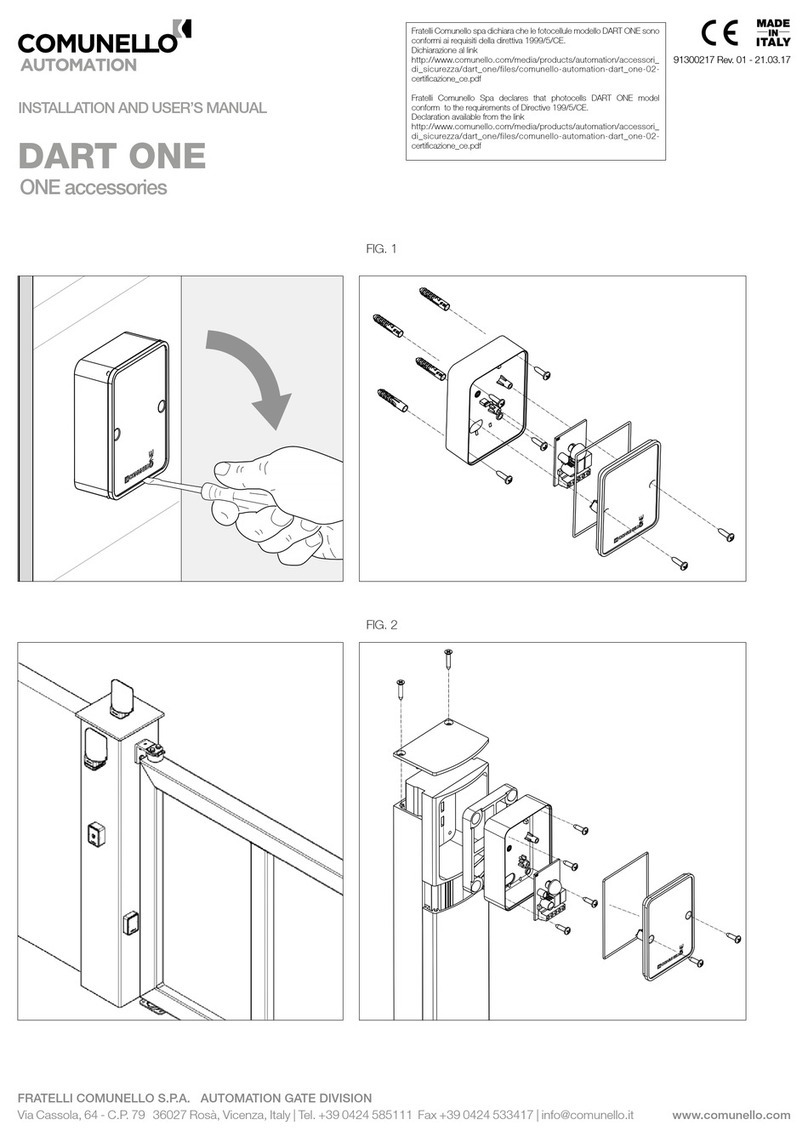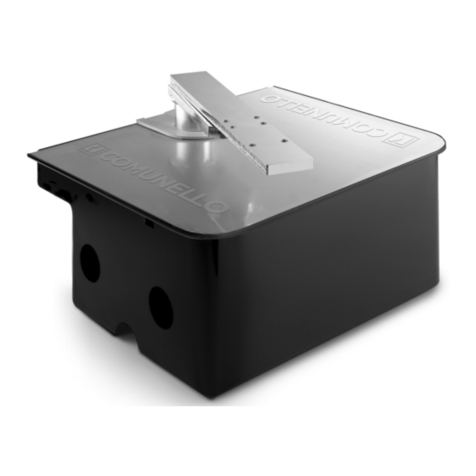
10
COMUNELLO ®Copyright 2017 - All rights reserved
2.2 INSTALLAZIONE TIPICA
E
C C
F F
G
BB
A A
D
F
LEGENDA
A MOTORIDUTTORE
B FOTOCELLULE IN APERTURA
C FOTOCELLULE IN CHIUSURA
D LAMPEGGIANTE
E SELETTORE A CHIAVE
F ARRESTO FINECORSA
G CENTRALINA ESTERNA
3 CARATTERISTICHE TECNICHE
DEL PRODOTTO
EAGLE / EAGLE ONE EAGLE
Alimentazione motore 24V 230V ~ 50Hz
Potenza assorbita 150 W 280 W
Assorbimento 6,5 A 1,2 A
Coppia 220 Nm 300 Nm
Intermittenza di lavoro Uso intensivo 0,3
Grado di protezione IP24D
Classe di isolamento 3 (selv) 1 (messa a terra)
Temp. di funzionamento da -20°C a + 50°C
Peso max del cancello VEDERE GRAFICO
Velocità 0,1 Rad / Sec 0,08 Rad / Sec
Peso 11,3 Kg 11,6 Kg
PESO ANTA (Kg)
LUNGHEZZA ANTA (m)
LIMITI DI IMPIEGO
4 INSTALLAZIONE
4.1 VERIFICHE PRELIMINARI
Prima di procedere all’installazione, è necessario vericare l’integrità dei
componenti del prodotto, l’adeguatezza del modello scelto e l’idoneità
dell’ambiente destinato all’installazione:
• Vericare che tutto il materiale da utilizzare sia in ottimo stato e adatto
all’uso previsto.
• Vericare che la struttura meccanica del cancello sia adatta ad essere
automatizzata. Il presente prodotto non può automatizzare un cancello
che non sia già efciente e sicuro; inoltre, non può risolvere difetti causati
da un’installazione errata del cancello o da una sua cattiva manutenzione.
• Vericare che le condizioni di funzionamento dei dispositivi siano
compatibili con i limiti d’impiego dichiarati.
• Muovere manualmente le ante del cancello nelle due direzioni e
accertarsi che lo sforzo sia costante.
• Portare manualmente le ante del cancello in una posizione qualsiasi;
quindi lasciarle ferme e accertarsi che non si muovano.
• Vericare che la zona di ssaggio del motoriduttore sia compatibile con
l’ingombro di quest’ultimo ed accertarsi che ci sia lo spazio sufciente
per la rotazione completa.
• Nelle vicinanze del motoriduttore, accertarsi che ci sia spazio sufciente
per effettuare la manovra manuale di sblocco del motoriduttore.
• Accertarsi che le superci scelte per installare i vari dispositivi, siano
solide e possano garantire un ssaggio stabile.
• Accertarsi che ciascun dispositivo da installare sia collocato in una
posizione protetta e al riparo da urti accidentali.
4.2 LIMITI D’IMPIEGO
Prima di eseguire l’installazione, vericare che il motore sia correttamente
dimensionato al peso ed alla lunghezza delle ante e sia nei limiti riportati nel
capitolo 3 “Caratteristiche tecniche del prodotto”.
4.3 LAVORI DI PREDISPOSIZIONE ALL’INSTALLAZIONE.
ASSEMBLAGGIO BRACCI SNODATI
• Eseguire uno scavo con dimensioni adeguate, per collocare la cassa di
fondazione (FIG. 1).
• Prevedere un condotto per il passaggio del cavo di alimentazione e uno
per il drenaggio dell’acqua (FIG. 2).
• Mettere la cassa di fondazione all’interno dello scavo, con il perno
allineato all’asse del cardine superiore (FIG. 3).
• Annegare nel calcestruzzo la cassa di fondazione, avendo cura di
metterla perfettamente orrizontale (FIG. 4).
4.4 INSTALLAZIONE
4.4.1 INSTALLAZIONE:
• Inserire il motore nella cassa di fondazione. (FIG. 5).
• Fissare il motore con i dadi e le rondelle in dotazione (FIG. 5).
• Saldare la piastra di aggancio come illustrato in FIG. 6.
• Fissare il meccanismo di sblocco manuale del cancello come illustrato
in FIG. 7.
• Assemblare la piastra P con il perno della cassa di fondazione inserendo
anche la sfera in dotazione (FIG. 8).
• Inserire nel foro della piastra P il perno della piastra di aggancio (FIG. 9).
• Rendere solidali le 2 piastre con il meccanismo di Blocco/sblocco
manuale come descritto nel Cap.4.4.3.
• Unire l’albero motore alla staffa P mediante l’utilizzo delle 2 leve (FIG. 10):
Inserire la leva A sull’albero motore e ssarla con vite e dado in dotazione.
Fissare la leva B alla leva A ed alla piastra P mediante i 2 anelli seeger
in dotazione.
4.4.2 INSTALLAZIONE FINECORSA
Se il cancello è provvisto di necorsa propri (consigliato) il cancello deve
arrivare a contatto con gli arresti stessi in apertura e chiusura. Se invece il
cancello non è provvisto di arresti o non si desidera far arrivare il cancello
in battuta con l’arresto è necessario utilizzare i necorsa interni all’attuatore.
Per regolare i necorsa interni proseguire come segue:
• Portare in completa chiusura l’anta (FIG. 11) e regolare la vite no a
toccare la leva B (FIG. 12).
• Ad anta completamente aperta (FIG.13) allentare il bullone di ssaggio
del necorsa in apertura (FIG. 14).
• Ruotare il necorsa no ad andare in battuta sulle leva B (FIG.14).
• Chiudere con il coperchio come illustrato in FIG. 15.
4.4.3 BLOCCO / SBLOCCO MANUALE DEL MOTORE
Lo sblocco manuale va attivato quando si deve aprire manualmente il
cancello. L’attivazione del sistema di sblocco potrebbe provocare movimenti
incontrollati del cancello nel caso in cui siano presenti sbilanciamenti o guasti
meccanici. In fase di installazione è necessario utilizzare tale meccanismo
per bloccare l’anta al sistema di leve e consentire la trasmissione del moto.
Esistono 3 tipi di sblocchi manuali del motore:
SBLOCCO MANUALE CON CHIAVE IN DOTAZIONE:
• Inserire la chiave nel cilindro e ruotarla nel senso consentito (FIG.16A).
• Tenendo la chiave ruotata spostare il cancello per ottenere lo sblocco
(FIG. 17A).
SBLOCCO MANUALE CON LEVA IN DOTAZIONE:
• Inserire la leva di sblocco e ruotarla nel senso consentito (FIG. 16B).
• Tenendolalevaruotataspostareilcancelloperottenerelosblocco(FIG.17B).
































